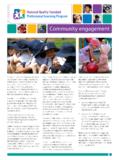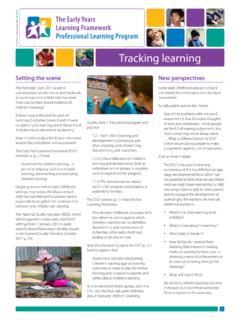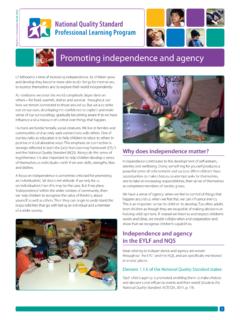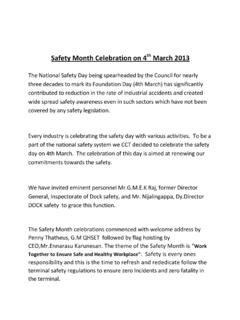Transcription of Collaborative partnerships with families
1 NQS PLP e-Newsletter 2012. Collaborative partnerships with families Setting the scene What are the characteristics of a The national Quality Framework and the national Early Years Collaborative partnership with Learning Framework (EYLF) ask educators to go beyond traditional families ? parent involvement activities to form respectful supportive relationships' with families (NQS Standard ). Standard The best experiences for children happen when there is a strong requires educators to support families in their parenting role relationship between you and the child's family that is evident in and to respect families ' beliefs and values about child rearing.
2 Your daily practice. These requirements are based mainly on Principle 2: partnerships The relationship with each family will be unique in many ways, in the EYLF. but all partnerships will share some features: Mutual trust Open, respectful communication Empathy Openness to others' views, values and perspectives Shared decision making Clarity about roles and responsibilities Appreciation of each other's knowledge and experience Willingness to negotiate and compromise Commitment to resolve tensions and conflicts Shared aims or goals what is best for the child. As the EYLF makes clear, partnerships between educators and families matter because: knowing that you respect their family strengthens a child's identity and sense of belonging and enhances their learning knowing children well also includes knowing the family and the cultural and community contexts of their lives families bring insights that offer a richer picture about their child.
3 Forming partnerships is not always easy, but always worth the effort. 1. Ann is an educator at Yooralla Narre What practices establish and strengthen Warren Central Children's Centre in partnerships ? Narre Warren Victoria, a community- based children's centre that actively The service philosophy statement should highlight and give priority to partnerships with includes children of all abilities. Ann families . Policies, procedures and everyday practices should link directly to the philosophy. spoke about her perspective on families : Some examples of practices that underpin partnerships include the following: From the beginning we pay attention 1.
4 Start building a sense of welcome and respect from the first interaction or conversation to what families want. In our initial you have with families . Let them know that you are keen to know what they want for contacts we ask them to tell us about their their child. child's interests and anything else they 2. Ensure that your enrolment and orientation procedures communicate messages about want us to know. We ask them to share partnership. any worries they have about their child coming to our service and what they wish 3. Offer a variety of ways for families to be involved in and contribute to the service if they for in their child's experience with us.
5 This choose to. Reflect on how those ways contribute to partnerships . tells us a lot about their priorities. They might say something like I want her to have friends' or I want him to be able to play with others'. We take those wishes very seriously. We have ongoing communication with families throughout their participation . via informal conversations, more formal planning meetings and the sharing of portfolios. When exploring why parents were not writing in their child's portfolio, we found that parents read it but didn't contribute when they saw that I had typed my contributions.
6 They said they didn't want to mess it up! So now I hand write my entries a bit messily and parents write more. We encourage families to stay as long as they want to. Some stay the whole session. Both the child and family need to trust us. My focus is not just the child it's the couple'. The child, the parent and their relationship matter most. I have a deep- seated belief that parents have their child's best interests at heart. It's just that things can get in the way of putting their child first. I have to continually reflect on my values and beliefs and how they might affect the ways I work with families .
7 I also have to make sure I don't see myself or come across to families as the expert'. 2. Janani, a family day care educator with the Glen Eira Scheme in Melbourne, spoke about beginnings of partnerships : What happens in the initial interview, how we interact and the information I share and ask for, are the first baby steps' towards a Collaborative partnership. If the family and child start to feel like they belong here, then we're on the road to a partnership. I keep in mind that families are the experts on their child. I can't really know how a parent feels, what they know or think.
8 Sometimes they don't know much about family day care so I need to tell them a lot, even when they don't have many questions. When they visit I tell them to think about whether my family day care is suitable for them and their child. When I speak to parents on the phone before they visit, I ask what their child likes to play with and I have that play material out when they visit. I try to let them decide the best time to visit my home, rather than telling them what's best for me. I do everything I can to make them feel welcome. I introduce the parent and child to everyone who is present, including the other children.
9 I have photos of each family on a family tree, and I ask new families to bring one to add. I tell parents they should stay as long as they want to, in the beginning and at any other time. What has developed is that some parents stay and read to the children or play with them when they drop their child off. The children love it. When I have celebrations all families are welcome. Once a year I. organise a get-together for families . I think the families feel a sense of community and belonging here. For example, recently I asked a parent where I could buy natural dye for playdough, because a child who has started attending is allergic to chemicals.
10 When she came back in the afternoon she brought some vegetable dye. She said she happened to be passing a health food shop and thought she'd check. This was not for her child she wanted to make a contribution to another child's experience. I want families to initiate contributing and to feel confident that anything they contribute will be welcomed. 3. 4. Communicate with families in different ways written, Rukmini, Director of the Monash (Caulfield) Child Care Centre electronic, and verbal. Keep in mind that conversations are in Melbourne, emphasises empowerment through family almost always the best way to communicate.
















